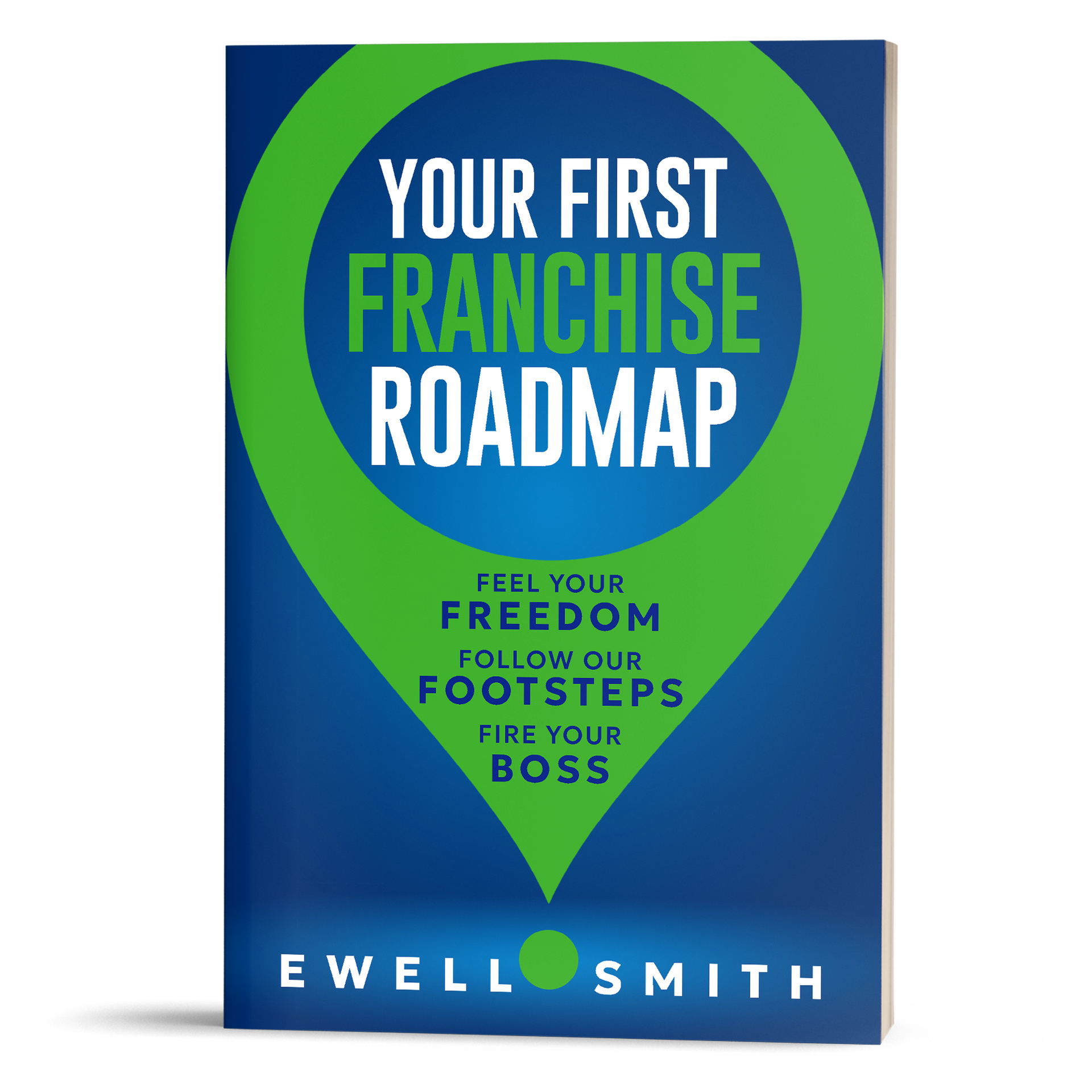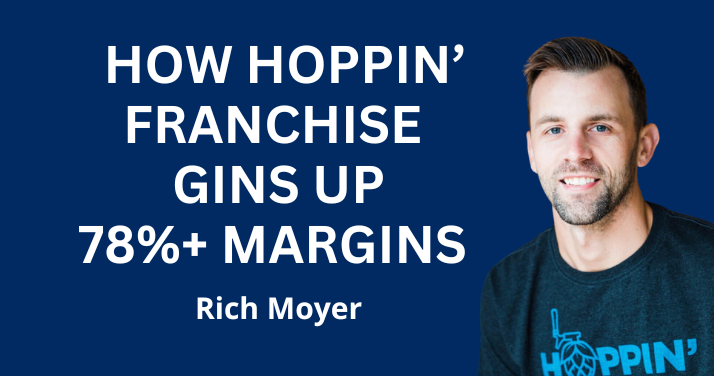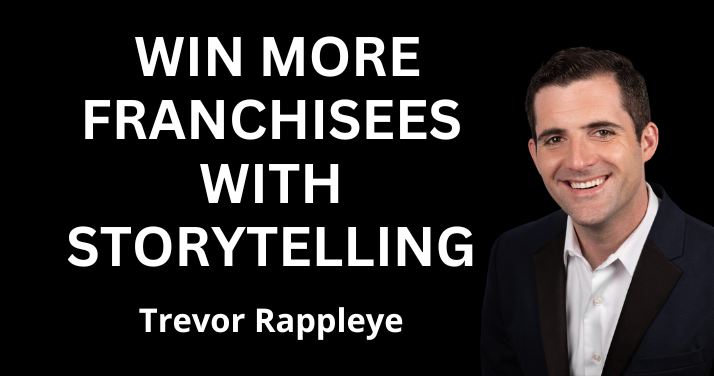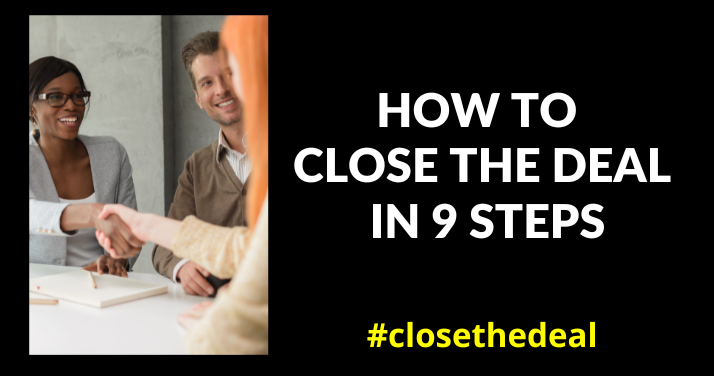
Close the Deal. Com is all about sales professionals and entrepreneurs closing more business deals in 2023.
Let's grow your revenue!
We'll break down what it means to "close the deal" into three parts:
- Close The Deal definition and the larger meaning
- 9 steps to help close the deal for success
- 15 closing techniques commonly used to close more sales
Close The Deal definition and the larger meaning
For starters, CloseTheDeal.Com views closing as part of a bigger picture which is very important. The very top sales professionals embrace this mindset…more on that in a second.
Let's first look at the formal definitions of close the deal per:
Merriam - Websters: to make an agreement official.
They also refer to "close the deal" as "seal the deal."
Cambridge Dictionary: to make a successful business arrangement with someone.
Circle Sales Sequence – the Bigger Picture
Regarding mindset, there’s more to closing the deal than a signature or credit card swipe.
We see the closing also serving as an opening.
With the deal closed, now you check on your customer to see that they are engaged with your product or service. Are they using it effectively? Are they pleased? If they are, they will recognize your genuine interest in their well-being to know they are satisfied.
Now the odds of repeat business and word-of-mouth marketing (the most valuable form of marketing) to expand upon the original sale increase significantly and organically.
We view closing the deal in the context of what we call the circle sales sequence.
Our larger objective is to rinse and repeat through the circular sales lifecycle over and over with the anticipation of establishing genuine long-term relationships.
9 Steps to Help You Close The Deal in 2023.
To your success!
This will serve as a step-by-step guide to best practices to build long term relationships.
Step 1. Open the deal. The first time you meet a prospect, establishing rapport immediately is critical. Do not pre-judge anyone. Treat every prospect with the utmost respect.
Finding ways to connect with your prospect is vital. Key things to do:
- Smile (even if it’s a phone call too – the prospect can sense it)
- Make sure you’re upbeat - the right attitude sets the tone to open and close the sale
- Go into the deal with genuine care. The deal is about them. The customer will sense if you make it about you.
- Get their name and call your prospect by name throughout your conversations with them.
- Explore shared interest, shared background, hometown, etc. to establish rapport quickly. The right questions work here. So do your eyes – meaning, when meeting the prosect for the first time. For example, if you’re on Zoom call, look at the room they are in and find an object in their room of shared interest if possible to spark the conversation. If you’re greeting your prospect in person, you may see an item they are wearing to make a comment on…anything you can use to connect.
- Be honest.
Without rapport, establishing a level of trust is impossible. Without trust, there is no sale.
When opening the deal, we also begin qualifying the person you're speaking with. Are you speaking to the decision-maker? If they are, are they potentially a good fit for the product or service you offer?
Putting their needs above yours to provide genuine value will set you apart from other sales people.
All of the above helps you build the relationship in the short term.
This first step opens the larger opportunity - turning your potential prospect into a long-term customer using the circle sales sequence is the higher objective.
Step 2. Diagnose the problem. Ask the important questions to understand your prospect's need(s). Drill down to the real problem they need to solve.
The # 1 thing you can do to close the deal once you start asking questions is to: Listen. Listen. Listen. (tip: all 9 steps depend on this) This simple act is especially important as you get to know your prospect and their issues.
If you do not know their real problem, it's impossible to solve their problem. No sale.
This step will help you further qualify your prospect and their needs.
As you ask the easy AND difficult questions, your prospect’s answers will help you determine if you can help them based on their feedback.
With the feedback provided, set expectations. Do not overpromise anything. When you know you can help solve their problem, then you can help them achieve their goal.
Step 3. Restate the problem. Restating your customer's problem and elaborating on the issues the problem can cause will earn their undivided attention to you.
Restating the problem lets the prospect know you listened to them intently and that you understand their problem clearly. It demonstrates you genuinely care. (the truth is many salespeople don't do this because they don’t listen well)
The goal is to tee yourself up as THE solution to your customer's problem as you speak to it directly.
Step 4. Share your special solution. In other words, make an attractive offer.
Your communication must be clear, concise, and compelling.
Your offer must solve their problem. It must be a great fit. There are two paths here:
a. If your product is one-of-a-kind and it solves a specific problem, go into the benefits.
b. If your product is not a one-of-a-kind solution, then oftentimes the benefits are commoditized because other competitors may offer the same or similar solution.
In this scenario, you don't want to fall into the commoditized trap. You need to demonstrate your value by sharing how your offer is unique – perhaps it's because of your level of service, your network, your skill level, your experience, etc.
Demonstrate what makes YOU different and communicate that to win the business. If you're like everyone else, who cares.
You need to stand out.
Step 5 - Anticipate the objections.
- Do your homework.
- Do the hard work others won't.
- Know your competitors' products' strengths and weaknesses very well and how your product stacks up against theirs. If you use scripts, know your scripts.
- Be prepared to address the objections. This will tee up your ability to negotiate effectively.
- Do your homework.
Step 6 – Negotiate smartly. Going into a meeting willing to compromise is a solid strategy. Enter the deal with certain concessions you are mentally prepared to offer (if needed).
A little give-and-take enhances your ability to overcome / address objections as they arise. It also helps to ease any stress you might have. That's important so your confidence shines.
At the end of the day, going into any negotiations with a little latitude or flexibility on your part increases your chance of coming to an agreement.
Note- it may not be everything you want or the other person wants, but a deal gets done through compromise that benefits both parties.
It's also very important to look past this deal. Perhaps this deal opens up more deals. This is the deal to establish your competency and trust with the customer who does not know your work just yet.
Get the business then build the relationship to do more business. Keep in mind the long-term objective of the circle sales sequence.
Step 7. Ask for the Sale. As crazy as this sounds, many sales reps will walk through the prior steps and never ask for the sale. They leave the deal wide open. As a sales professional, your mission is to open the deal, nurture the deal and close the deal.
Depending on the product or service, closing the deal may take some time. It may take several asks to get to a final decision.
Closing starts with the first ask.
Ask for your customer's business.
Step 8. Follow-up. Follow-up. Follow-up. This is what separates the amateurs from the sales professionals. Be consistent in your follow-ups. Persistence matters.
The sales process may be fast or take multiple asks or months or even years depending upon the sales cycle of the product or service. It may take a string of revised proposals to ease concerns or sweeten the pot. Whatever it is, your firm commitment to follow-up absolutely helps you close more deals.
Think about this - with a specific customer who’s vetting various proposals, you may be the only sales professional following up effectively to close the deal. That may be the only differentiator you need today to get the deal done.
Step 9. Follow up some more.
We refer to this as the infinite next step. Once the deal is closed, per our opening comments, we continue the follow-ups after the signature or credit card swipe. We’re now immersed in the circle sales sequence. This is how we circle back to step one with the same customer which helps expand our network and influence naturally.
This creates two opportunities:
1. The best customer to sell to is the one you already have that's satisfied. You've already made a positive impact. That's your number one prospect. They trust you. Now that they are engaged with your product or service, you can explore to see if they might need additional products or services you offer.
2. Ask for referrals through this process where it makes sense to grow your customer base. Your next potential customer or potential client may be your new customer’s best friend, spouse or co-worker.
Every step of the circle sales sequence is an important step to close more sales. This process by default nurtures:
- caring for your customer >
- building competence through experience >
- growing your confidence over time >
- closing more deals!
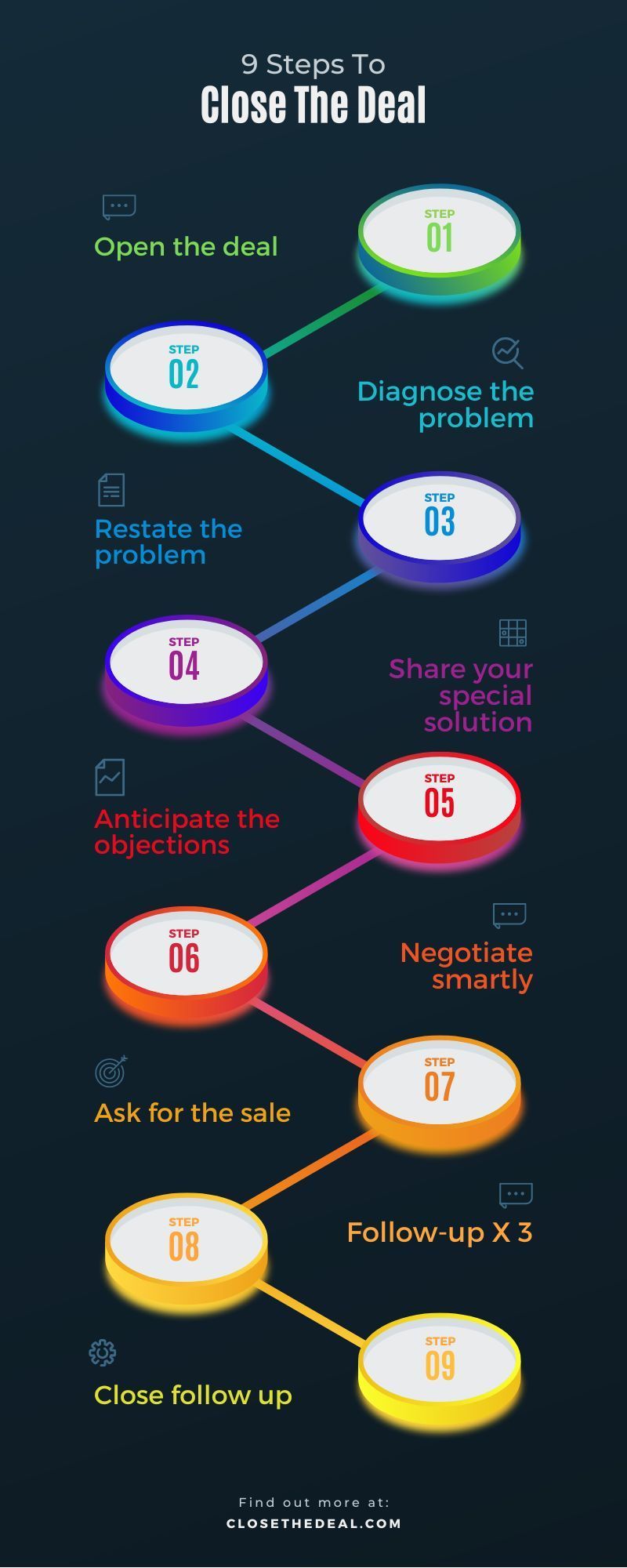
15 Closing Strategies / Tactics
Let's now go into the tactics regarding the most talked about part of the circle sales sequence - close the deal.
Keep in mind, three things may influence which strategies you might use:
a. Your personality – you will likely need to stretch your comfort zone if the sales strategy that suits you best doesn't work at first. You will need to test the other strategies.
b. The sales situation itself. The situation may warrant using certain strategies over others or a combination of strategies
c. Timing is important. At which stage the ask is being made or the follow-up asks are being made can vary based on the feedback.
1. The trial close: This strategy helps you test how warmed up the prospect is to the solutions you're offering. This may be a soft ask to see if you're going in the right direction. You're looking for a positive response here. You can ask for small commitments along this journey to tee up the final close.
2. The direct close: This strategy cuts to the chase. With confidence, the sales person is sure the prospect is ready. For some prospects, it may be too direct and may not be the best approach.
3. The assumptive close. With this strategy, you're sensing the buyer is primed and ready. You feel this is the right time, but you take a lighter, less direct approach. If you've done your job well educating your customer, this may be your softer close.
4. The summary close: Use this strategy if you sense the buyer may not be as ready. The buyer may need to be reassured with a summary of how the benefits of your product or service help solve their problem.
5. The alternative close: This strategy is helpful if you're uncertain of the direction the customer is going regarding the problem or problems you can help them solve. This presents an opportunity to identify two desirable options and offer up both to see which resonates best with the customer. In this process, you can position one option as the one that's favorable to you and genuinely the right choice to best serve the customer. (the long game matters in the circle sales sequence)
6. The question close: This strategy involves asking the prospect closing questions to engage the prospect and prompt them to consider the value of the product or service being offered. By asking targeted questions, the sales rep can guide the prospect to a better decision. This process helps bring the prospect closer to a successful sale.
7. The objection close: This strategy addresses the issues the prospect likely feels have not been answered just yet. You need to put your prospect's objections at ease. Be prepared to know the common objections to overcome without hesitation. Anticipation matters here; objections are coming.
8. The balance sheet close: Using this strategy, you're presenting your product or service alongside other options another salesperson or company may offer. You stack your offer up against the competition knowing the benefits of your product or the overall offer itself is more compelling when viewed side by side on a balance sheet.
9. The urgency close: This strategy creates a sense of urgency using FOMO – "fear of missing out." Common tactics used are time deadlines. Once the clock expires, the offer expires. Another tactic is to let the customer know there is a limited supply available (this needs to be genuine and truthful for you to be taken seriously or trusted). This process will help expedite the sale.
10. The takeaway close: This strategy is a sister to the urgency close. Fear of missing out is powerful. Having a deal taken away is playing harder ball. You're now presenting the circumstances of not taking action or not making a purchase which can help encourage the customer to act quickly.
11. The vision close: This strategy is a softer close than the takeaway close. The vision close paints a clear picture for your customer to see how their life will be with your product or service or without your product or service. With your offering, life is good. Without your offering, life is not as good.
12. The emotional close: This strategy tugs on the heartstrings of the customer. Through the circle sales sequence, you've gotten to know your customer well. You know what connects with them and you're addressing a more compelling "why" than price alone or benefit comparisons.
13. The testimonial close: This strategy involves using positive testimonials or endorsements from satisfied customers. This tactic helps the prospect see what might be possible for them if they make a purchase. This can be quotes from satisfied customers or in story form in writing or video. This helps establish trust in the product or service you're offering.
14. The discount close: This strategy works well if you're intentionally trying to get rid of inventory. This strategy can also set a bad precedent if you're only selling on price undermining the genuine value of your product or service. Keep in mind the circle sales sequence as you're setting the customer's expectations for future sales. Use discounts strategically to your advantage, not your disadvantage.
15. The follow-up close. To further emphasize the very important point we made above regarding Step 8 (of 9), this strategy may use any of the above strategies (or a combination of strategies) if the close doesn't happen on the first ask.
Sharpening your skills determines your bottom line.
The bottom line is we want to close more deals, sign more contracts, and sell more products or services.
That means:
- Becoming highly effective communicators.
- Listening well.
- Being empathetic to connect and build rapport.
- Being fearless to ask hard questions.
- Understanding the problems that need solving.
With practice and experience sharpening your negotiation skills, sales professionals like you eliminate many of the hesitations and concerns the prospect may have.
Altogether this leads to closing more business deals.
Now - this is your time to close the deal!
Make it a great day!
Ewell.
Subscribe
Close The Deal Leveraging
Multi-Unit Franchising. Click here.
Considering your first franchise, you've got options. Click here.
Your First Franchise Roadmap on Sale Soon
Don't miss a thing.
We share opportunities and updates with you
as they come our way
...network with us:
We will get back to you as soon as possible
Please try again later
New Paragraph







